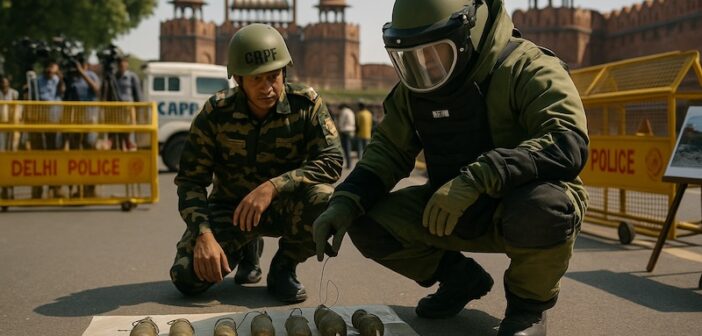TL;DR The deadly Red Fort blast of November 2025, which killed 15, highlights India’s security crisis, particularly the sophisticated terror networks moving explosives undetected. From 2011 to 2024, the CRPF recovered nearly three lakh detonators, two lakh rounds of ammunition, and thousands of bombs/IEDs. Such operations are an important defence against “white-collar terrorism,” refined bomb-making, and cross-border modules like Jaish-e-Mohammed, which, when unchecked, quickly strike, as seen in the 2025 Red Fort Blast, and the terrorist attacks in the past in Mumbai, Hyderabad and other places.
Context
On 10 November 2025, a Hyundai i20 packed with an ammonium nitrate fuel-oil (ANFO) device exploded near Delhi’s Red Fort Metro station, killing 15 people and injuring more than 20. The investigation that followed uncovered a sophisticated white-collar terror module run by radicalised doctors, engineers, and medical faculty, individuals who blended seamlessly into professional spaces while building high-grade explosives.
Reports indicate that raids in Faridabad revealed over 2,900 kg of explosive-making material, along with operational links to Jaish-e-Mohammed’s networks in Kashmir and Pakistan. The involvement of surgeons, professors and paramedics marks a shift toward a new era of terrorism in India, one where technical expertise, academic credibility and digital insulation are weaponised for high-impact, low-detection operations.
This is exactly why recoveries matter: every bomb seized is an attack prevented, and every detonator intercepted is a catastrophe averted.
Who Compiles This Data?
The operational recovery data is compiled by the Ministry of Home Affairs (MHA) and published annually through its official reports. These records capture recoveries made during CRPF’s wide range of operations, including counter-terrorism, anti-militancy, anti-insurgency, anti-Naxal campaigns, as well as actions taken to maintain law and order.
Where can I download Clean & Structured Data about CRPF recoveries?
Clean, structured, and ready-to-use datasets related to CRPF’s arms, ammunition, IED and bomb recoveries (year, category, quantity) can be downloaded from Dataful.
Key Insights
IEDs & Bombs: Direct Indicators of Attack Planning
The strongest signals of an imminent terror strike are IEDs (Improvised Explosive Devices) and recovered bombs. These are not raw materials; they are finished weapons, often fully wired, assembled, and in many cases only one trigger away from deployment. IEDs remain the preferred weapon for Naxal groups because they are affordable, easy to hide, and can be built from widely available components. Bombs, whether timer-based, pressure-triggered, command-wired or vehicle-borne, reflect a network’s readiness for coordinated, high-casualty attacks.
Over the years, India has seen dramatic swings in these recoveries. For instance, device counts were extremely low in 2011–12 but surged in 2013–14 with more than 500 bombs and over 500 IEDs recovered, one of the largest combined device hauls in a single year. Later, 2015–16 saw over 1,300 IEDs seized, and in 2023–24 recoveries climbed further, with more than 1,500 IEDs and nearly 400 bombs documented. These large device hauls often indicate that a major attack or sometimes several were foiled at the preparation stage.
Detonators: The Multipliers Behind Urban Terrorist Attacks
If IEDs and bombs represent the output of a terror network, detonators are the critical input. They serve as the ignition system that allows explosive material to detonate; without them, most explosives cannot be weaponised at all. Their presence in large quantities is therefore more than a manufacturing detail; it is a sign of scalable attack potential.
Some years show staggering quantities of these components being seized. The most striking is 2017–18, when over 193,000 detonators were recovered, an astronomical figure that suggests the dismantling of a massive supply chain or the discovery of multiple stockpiles. These materials enable militants to scale up production; a single large cache can translate into dozens or even hundreds of IEDs. Large seizures, therefore, imply not just an individual plot being foiled, but the interruption of entire manufacturing capabilities.
Arms & Ammunition Recoveries: The Kinetic Context
Arms and ammunition reveal the kinetic side of militant operations: ambushes, firefights, assassinations, and hybrid attacks combining firearms with explosives. The data shows that even as bomb-making becomes more sophisticated, militants continue to stockpile weapons at scale.
Ammunition recoveries were particularly high in the early 2010s, with over 39,000 rounds seized in 2011–12 alone, coinciding with intensified anti-Naxal operations. Weapons recoveries also peaked during this period, with more than 1,000 arms seized in both 2011–12 and 2013–14. More recent figures continue to highlight the scale of the threat: in 2023–24 alone, the CRPF recovered over 600 weapons and more than 21,000 rounds of ammunition. These numbers indicate that despite ongoing crackdowns and surveillance improvements, armed engagement remains a significant dimension of India’s internal security challenge.
Historical Precedents: Blasts That Shaped India’s Policy
India’s counter-terror policy has been fundamentally shaped by major bombings in the past decade, several of which closely mirror the materials and methods reflected in the recovery data.
1. 2011 Mumbai Blasts
On 13 July 2011, coordinated explosions at Opera House, Zaveri Bazaar and Dadar killed 26 people and injured more than 130. The attacks used ammonium nitrate–based IEDs mixed with fuel oil, the same compound later seen in the 2025 Red Fort blast. These blasts exposed vulnerabilities in urban surveillance, multi-point coordination, and precursor chemical regulation.
2. 2013 Hyderabad Blasts
On 21 February 2013, twin explosions rocked the busy Dilsukhnagar area, killing 18 and injuring at least 119. The bombs were packed with iron nails, bolts and ammonium nitrate, tightly bound with copper wiring to maximise shrapnel spread. The precision of these devices reflected skilled bomb fabrication and meticulous planning.
These and similar attacks triggered major reforms, including expansion of NIA powers, the establishment of NTRO’s dedicated surveillance systems, tighter regulation of ammonium nitrate, and a new emphasis on counter-radicalisation and monitoring of digital communication channels.
Why Does It Matter?
Every explosive, detonator, or weapon recovered is a potential attack prevented. The year-wise data shows that terrorism in India is evolving. Bomb-making materials are easier to source, white-collar radicalisation is rising, and both Naxal and urban terror modules continue to adapt their methods.
Key Numbers (from 2011-12 to 2023-24, in absolute numbers)
- Ammunition recovered:
2011-12: 39122 → 2017-18: 15214 → 2023-24: 21354 - Arms seized:
2011-12: 1266 → 2017-18: 492 → 2023-24: 620 - Detonators:
2011-12: 14 → 2017-18: 193527 → 2023-24: 34604 - Bombs:
2011-12: 3 → 2017-18: 166 → 2023-24: 374 - IEDs neutralised:
2011-12: 16 → 2017-18: 364 → 2023-24: 1573
Note: Thumbnail created using ChatGPT



